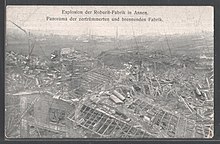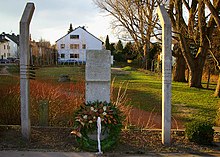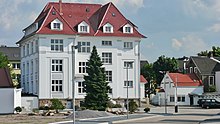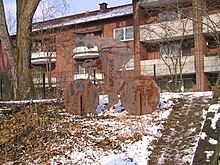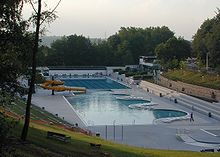Anne (Witten)
|
Anne
City of Witten
Coordinates: 51 ° 26 ′ 59 ″ N , 7 ° 22 ′ 32 ″ E
|
|
|---|---|
| Area : | 12.11 km² |
| Residents : | 18,250 (June 30, 2015) |
| Population density : | 1,507 inhabitants / km² |
| Incorporation : | August 1, 1929 |
| Postcodes : | 58453, 58454, 58455 |
| Area code : | 02302 |
|
View over the center of Annen
|
|
Annen is the largest of the seven districts of Witten .
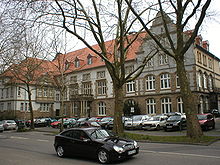
history
Beginnings
A village called Anadopo was first mentioned in 1150 . Local researchers assume, however, that Annen is significantly older. In the neighboring village of Salingen , for example, the first farms were settled in 801, and in Persebeck in 820. A treasure book of the county of Mark in 1486 shows that there were ten farms in Annen that year. Interestingly, some of the farms were subject to tax from different landlords, for example the Counts of Dortmund and the Werden Abbey .
19th century

General
During the occupation of the region by Napoleonic troops at the beginning of the century, Annen became part of a newly founded Mairie Witten , so Annen became part of Witten for the first time. After the withdrawal of the French troops, Witten retained his mayor's office, but Annen was relocated from this mayor's office as part of a spatial reorganization. Instead, Annen was initially assigned to the Dorstfeld office in 1819 . With the village Wullen formed Annen henceforth the rural community of Annen-Wullen . At the end of the 19th century, the rural community was assigned to the district of Hörde after the establishment of its own office . The name part Wullen was dropped.
railroad
In 1848 Annen-Wullen was connected to the Hagen-Witten-Dortmund railway line of the Bergisch-Märkische Eisenbahn-Gesellschaft . For Annen, however, the construction of the railway line from Langendreer to Löttringhausen in 1878, which also led via Annen, was of particular economic and political importance . The line, popularly known as the Rheinischer Esel , offered the most important mines of Annens a direct siding.
Mining industry
When coal was first mined in Annen is controversial among historians. In the middle of the 19th century, however, the first civil engineering mines were opened in Annen. The settlement of the Hamburg Mines in 1851 and Ringeltaube (1864) brought new residents to the community. In 1875 Annen-Wullen had 5643 inhabitants, in 1890 there were already 8342. Most of the men worked in heavy industry. In addition to mining, several glassworks and brickworks were built, as well as the F. Asthöwer & Co. steelworks in 1870 (Annenstraße 113; taken over by Friedrich Krupp in 1886 ) and the Annener cast steelworks (Stockumer Straße 10) in 1873 .
20th century
Annen experienced a first crisis at the beginning of the 20th century. With the closure of many small mines in the Ruhr Valley at the end of the 19th century and, above all, with the north migration of the Ruhr mining industry, the large Annen mines also lost their importance. When the mining companies transferred the sales quotas allocated to them by the Rheinisch-Westfälischer Kohlen Syndikat to more profitable collieries in the Emscher area, they largely stopped mining in the southeastern Ruhr area.
In November 1906, the Roburit security explosives factory in Witten, right on the city limits of Annen, exploded, killing 41 people. Due to the topographical conditions, the enormous pressure wave spread to Annen in particular, so that there the damage to buildings and household effects was far greater than in Witten. The property damage was estimated at around 2.5 million marks . State aid for reconstruction was not paid, and the fire insurance companies refused compensation. About a sixth of the property damage was compensated through fundraising.
After the First World War , Annen's economy went downhill. The coal mines were all closed, including Fried. Krupp AG sold its Annen branch. In 1922 Rüdinghausen was incorporated into Annen, which increased tax revenue and strengthened the community's position. However, since Annen had no town charter, it was only a matter of time before Annen would lose his independence as an office. In 1929, Annen became a district of Witten as part of the community reform . Rüdinghausen also received the status of a district, while Wullen was downgraded to a district.
During the Second World War , the town center was badly affected by Allied bombing attacks, especially because of the important armaments factory directly adjacent. From September 1944 to March 1945, the Annen Gußstahlwerk satellite camp was located in Annen . The men living in the camp had to do forced labor in the Annen cast steelworks . A small memorial stone on the edge of the camp that was demolished after the war commemorates the victims of this barbarism.
After the Second World War, housing estates for British soldiers from the Dortmund barracks were built in Annen. When the barracks were dissolved in the early 1990s, the British houses in Witten were also given up and sold.
21st century
Today, Annen is Witten's largest district. Around 18,300 people (as of December 31, 2014) live in the secondary center. After the Wickmann-Werke moved away, the city of Witten set up its technical town hall in its administration building. Another local authority authority at the Ostermann headquarters is the JobAgentur - EN . At the same location there is a branch of the city library and the QuaBeD qualification and employment company .
Boroughs
- Beading (42)
- Annen-Middle-North (43)
- Annen-Middle-South (44)
- Coal Sieves (45)
- Wartenberg (46)
- Gedern (47)
(The number in brackets is the city district code.)
education
- 4 primary schools
- 1 secondary school
- 1 comprehensive school
- 1 Waldorf school
- Seminar center of the VHS Witten / Wetter / Herdecke
- University of Witten / Herdecke , founded in 1982 as the first private German university
- Institute for Waldorf Education
Economy and Infrastructure
traffic

- A 44 , motorway junction Witten-Annen
- Witten-Annen Nord station on the S5 S-Bahn line
Culture and sights
Attractions
- Roman Catholic Church of St. Joseph ; The church was built in two construction phases 1880–1881 and 1903–1904 (expansion with transept ) by the Paderborn diocesan master builder Arnold Güldenpfennig . On January 1, 1913, the elevation to an independent parish took place. The bell of the church consists of three bells from the bell and metal foundry Carl Munte . The E-tone bell weighs 920 kilograms and is dedicated to St. Joseph . The G-tone bell weighs 525 kilograms and is consecrated to St. Boniface , while the A-tone bell, the smallest, weighs 386 kilograms and is consecrated to St. Liborius . The two small bells are new casts, as the originals were melted down during World War II ; In contrast to the large bell, they are no longer made of bronze , but of cast steel .
- Protestant Church of the Redeemer ; Laying of the foundation stone in 1872, completion in 1874; Organ from 1968 with 31 stops on 3 manuals and pedal; under monument conservation
- Marktfrau , sculpture on the Annen market square
- Georg Hotel ; The interiors designed by Herbert Antweiler are entirely in the style of organic architecture . The color design of the facade and the interior was designed by Robert Kaller .
Leisure time
- " Rhenish donkey " cycle path
- Imberg quarry , youth meeting place, outdoor with a small hall
Sports clubs and facilities
- Sport-Union Annen's Kälberweg sports center, each with its own facilities for judo , wrestling , bowling , dancing , tennis , mini golf and accompanying infrastructure such as sauna , fitness and massage rooms
- 1 indoor swimming pool
- Football club VfB Annen
- DJK Blau Weiß Annen
- Annener Gymnastics Federation from 1872 (ATS); On January 1, 2007, it gave up its independence to merge with the TuS Witten-Stockum 1945 eV. It still exists as an independent department of TuS Witten-Stockum, the league and competition gymnastics ATS.
Annener outdoor pool
The Annen outdoor pool is located on the site of the former Steinbach dam. It was created as a fish pond at the beginning of the 20th century. A few days after the explosion of the Roburit factory in 1906, the dam broke. A connection with the Roburite explosion was never officially established. There was hardly any indirect damage. Unlike when the dam wall of the small dam , which was now used for swimming and ice skating, broke again in the mid-1920s . This resulted in major damage, including on the Hamburg colliery downstream .
After the second dam breach, an outdoor swimming pool was built by the unemployed at the same location and opened on August 19, 1928. It had a 20 × 75 meter pool, which was divided into a swimmer and non-swimmer pool by a bridge with starting blocks. It also had a diving tower about 5 meters high, which was in operation in its original form until 1974. In 2006 the extensive renovation work over several years was completed. The outdoor pool has been equipped with stainless steel tubs since then. The surrounding area was terraced in the lower area and a water play area was created far away from the deep pools.
Even today, the profile of the terrain and the structure reveal its origins as a dam. In 2004 a nearby road was given the name Zur Talsperre as a souvenir .
The special shape of the swimming pool is recognized by a double-print special postage stamp worth 2 times 0.95 euros from Deutsche Post . It was published on July 2, 2020 and shows the striking basin from above.
Personalities
- Wilhelm Lennemann (born September 24, 1875 in Annen; † January 23, 1963 in Witten), writer
- Robert Graf (born November 18, 1923 in Witten; † February 4, 1966 in Munich ), theater and film actor
- Klaus Rost (born March 2, 1940 in Witten), wrestler, won 14 German championship titles and a silver medal in freestyle at the 1964 Olympic Games in Tokyo
- Tanja Wedhorn (born December 14, 1971 in Witten), actress ( Bianca - Ways to Happiness )
- Lakmann One (born September 20, 1978 in Witten), German rapper
literature
- Heinrich Schoppmeyer : Witten. History of the village, town and suburbs. 2 volumes, Association for Local and Local Studies in the Grafschaft Mark (VOHM), Witten 2012, ISBN 978-3-00-040266-1 .
- Christian Lukas : Witten-Annen. (= Archive images ) 1st edition, Sutton Verlag , Erfurt 2012, ISBN 978-3-9540000-4-3 .
- Frank Ahland, Stefan Nies, Ingrid Telsemeyer (eds.): Sprengstoff! The explosion of the Witten Roburit factory in 1906. Klartext Verlag , Essen 2006, ISBN 3-89861-705-X .
- Stadtsparkasse Witten (ed.): Annen. History and Stories 1874–1999. Bochum 1999. (without ISBN)
- Manfred Grieger , Klaus Völkel: The “Annener Gußstahlwerk” (AGW) subcamp of the Buchenwald concentration camp, September 1944 to April 1945. Klartext Verlag, Essen 1997, ISBN 3-88474-647-2 .
- Jürgen Dodt, Wilhelm Fisse, Karl-Gustav Sprave, Gabriele Schnurr: Annen. From a farming village to an industrial location. 12th century until incorporation in 1929 . Ed .: History Association Witten-Annen. 1st edition. History Association Witten-Annen, Witten 2010 (without ISBN).
- Wilhelm Fisse: From independent office to suburb. Annen 1918–1929 . Ed .: History Association Witten-Annen. 1st edition. Witten-Annen History Association, Witten 2013.
Web links
Individual evidence
- ↑ a b c Information on the area and the population of the districts ( Memento from April 11, 2015 in the Internet Archive )
- ↑ Outdoor pool from above Westfalenspiegel July 2, 2020, accessed July 24, 2020

